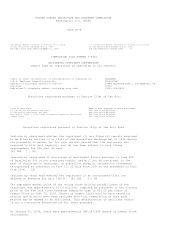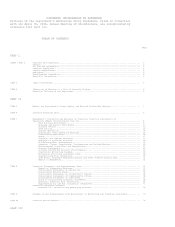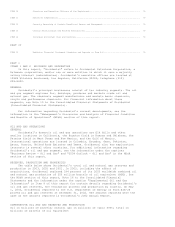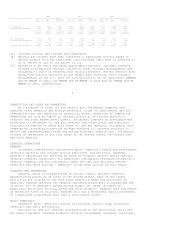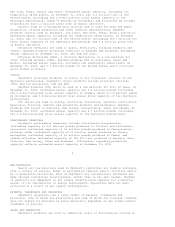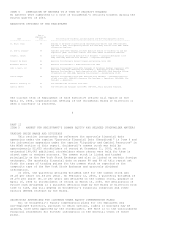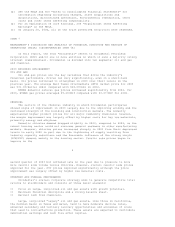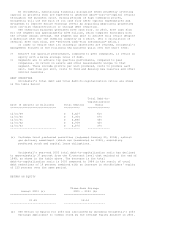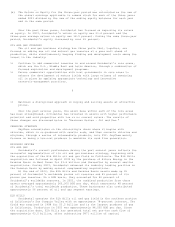Occidental Petroleum 2003 Annual Report Download - page 5
Download and view the complete annual report
Please find page 5 of the 2003 Occidental Petroleum annual report below. You can navigate through the pages in the report by either clicking on the pages listed below, or by using the keyword search tool below to find specific information within the annual report.New York, Texas, Brazil and Chile. Estimated annual capacity, including two
temporarily idled plants, at December 31, 2003, was 3.4 million tons in the
United States (including the 0.9-million-ton total annual capacity of the
OxyVinyls partnership, owned 76 percent by Occidental and 24 percent by PolyOne
Corporation) and 0.3 million gross tons in Brazil and Chile.
Caustic soda is co-produced with chlorine and is used for pulp and paper
production, alumina production and other chemical manufacturing. OxyChem
produces caustic soda in Delaware, Louisiana, New York, Texas, Brazil and Chile.
Estimated annual capacity, including two temporarily idled plants, at December
31, 2003, was 3.5 million tons in the United States (including the 1-million-ton
total annual capacity of the OxyVinyls partnership) and 0.4 million gross tons
in Brazil and Chile.
Potassium chemicals are used in glass, fertilizer, cleaning products and
rubber. OxyChem produces potassium chemicals in Alabama and Delaware. Estimated
annual capacity at December 31, 2003, was 429,000 tons.
Ethylene dichloride (EDC), a chlorine derivative, is a raw material for
vinyl chloride monomer (VCM). OxyChem produces EDC in Louisiana, Texas and
Brazil. Estimated annual capacity, including one temporarily idled plant, at
December 31, 2003, was 3.0 billion pounds in the United States and 0.3 billion
gross pounds in Brazil.
VINYLS
OxyChem's principal producer of vinyls is its 76-percent interest in the
OxyVinyls partnership. OxyChem's vinyls products include polyvinyl chloride
(PVC) and its precursors, VCM and EDC.
OxyChem produces VCM, which is used as a raw material for PVC, in Texas. At
December 31, 2003, estimated annual capacity was 6.2 billion pounds (including
the 2.4-billion-pound total annual capacity of OxyMar, which is 67-percent owned
by Occidental and 3.8-billion-pound total annual gross capacity of the OxyVinyls
partnership).
PVC resins are used in piping, electrical insulation, external construction
materials, flooring, medical and automotive products and packaging. OxyChem
produces PVC resins in Kentucky, New Jersey, Pennsylvania, Texas and Canada. At
December 31, 2003, estimated annual capacity was 4.7 billion pounds (including
the 4.5-billion-pound gross annual capacity of the OxyVinyls partnership).
PERFORMANCE CHEMICALS
OxyChem's performance chemicals include chlorinated isocyanurates
(estimated capacity of 131 million pounds produced in Illinois and Louisiana),
resorcinol (estimated capacity of 52 million pounds produced in Pennsylvania),
antimony oxide (estimated capacity of 33 million pounds produced in Texas),
mercaptans (estimated capacity of 18 million pounds produced in Texas) and
sodium silicates (estimated capacity of 722,000 tons produced in Georgia, Ohio,
Illinois, New Jersey, Texas and Alabama). Information regarding production
capacity reflects estimated annual capacity at December 31, 2003.
4
RAW MATERIALS
Nearly all raw materials used in OxyChem's operations are readily available
from a variety of sources. Power is provided by regional public utilities and/or
by co-generation facilities. Most of OxyChem's key raw-materials purchases are
made through contractual relationships, rather than on the spot market. OxyChem
is generally not dependent on any single nonaffiliated supplier for a material
amount of its raw-material or energy requirements. Operations have not been
curtailed as a result of any supply interruptions.
PATENTS, TRADEMARKS AND PROCESSES
OxyChem's operations use a large number of patents, trademarks and
processes, some of which are proprietary and some of which are licensed. OxyChem
does not regard its business as being materially dependent on any single patent,
trademark or process.
SALES AND MARKETING
OxyChem's products are sold to industrial users or distributors located in

